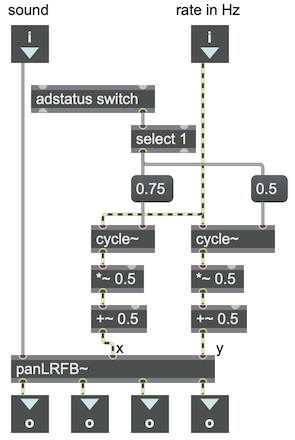Circular quad panning

This patch demonstrates the use of the cycle~ object to control quadraphonic panning in such a way as to simulate circular movement of a sound. It's an abstraction that can be used inside another patch to provide 4-channel distribution of a sound source. This abstraction uses another abstraction, which in turn uses another abstraction. So, in order for this patch to work, you will also need the panLRFB~ abstraction demonstrated in "Abstraction for quad panning using x,y coordinates", and the pan~ abstraction demonstrated in "Constant-intensity panning subpatch". You will need to ownload those two abstractions and save them with the correct names in your Max file search path.
The panLRFB~ abstraction expects values in the range from 0 to 1 in its second and third inlets, to specify the left-to-right panning and the front-to-back panning of the sound coming in its first inlet. To simulate circular movement of the sound, we use two low-frequency sinusoidal waveforms that are 1/4 cycle out of phase with one another, one to control the left-to-right panning and the other to control the front-to-back panning. Because the range of the cycle~ objects' output is from -1 to 1, we need to do a little math to convert that range to 0 to 1, by multiplying by 0.5 and adding 0.5, making the range suitable for input to the panLRFB~ abstraction.
When MSP is turned on, the cycle~ object is in cosine phase (i.e., starts at 1) by default. You can alter the phase of a cycle~ by adding a phase offset amount in its right inlet. To ensure that our two cycle~ objects are exactly 1/4 cycle out of phase with each other, their phase offset is triggered by a notification that MSP has been turned on, which comes from the adstatus switch object. The phase offset values 0.75 and 0.5 were chosen so that the sound will initially be panned to the center-front of the four speakers when MSP is turned on. The value in the right inlet of this patch will determine the rate of circular revolution of the sound. 0 Hz means no movement, a positive rate causes clockwise movement, and a negative rate causes counter-clockwise movement. For example, a rate of -0.05 Hz would cause the sound to circle the space counter-clockwise once every 20 seconds.
Because this panning method uses both left-right panning and front-back panning, for most locations on the circle all four speakers are diffusing sound. The combination of the two types of panning gives a fairly convincing constant-intensity circular panning effect. This is different from another method, shown in "Quadraphonic panning based on radial angle" and encapsulated in the quadpan~ abstraction described there. In that case, a single value from 0 to 1 for radial angle is used, and the sound is panned only to the two speakers that are nearest to that angle.